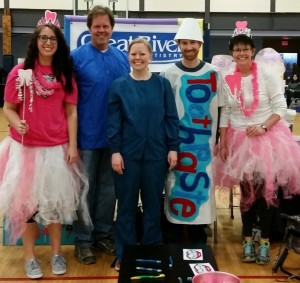Digital impressions use a scanning wand to quickly capture thousands of photos of the teeth and tissues in your mouth. A computer combines these photos to create an accurate, virtual replica of your mouth. This virtual model can then be transferred to a lab to make your crown, bridge, mouthguard, or other appliance. We are excited to have this technology available for our patients!
Choosing Wisely, a resource for patients
The American Dental Association is collaborating with Choosing Wisely, an initiative of the American Board of Internal Medicine Foundation, in an effort to help patients make educated choices about health care. In addition to conversations with their dentist, patients can access evidence-based information on the website to help make informed decisions about dental treatment. Visit ADA.org or choosingwisely.org to learn more!
Antibiotic Prophylaxis
Are antibiotics needed before a dental appointment? Learn more about current recommendations for patients with cardiac conditions and patients with prosthetic joints by clicking here.
GRD at Tiny Tots Expo!
 Thank you to everyone who attended the Tiny Tots Expo at the Boys and Girls Club last weekend! It was a great morning for kids to learn about teeth (and to visit with the tooth fairy). To learn more about caring for the teeth of your tiny tot, check out this link for some helpful resources.
Thank you to everyone who attended the Tiny Tots Expo at the Boys and Girls Club last weekend! It was a great morning for kids to learn about teeth (and to visit with the tooth fairy). To learn more about caring for the teeth of your tiny tot, check out this link for some helpful resources.
Microbeads in the News
Despite their tiny size, microbeads have been getting big attention lately.
Microbeads are tiny non-biodegradable spheres of plastic (polyethylene) that can be found in exfoliating products such as face washes and soaps, but can also be in products such as chewing gum and toothpaste. People are wondering…are microbeads safe? The American Dental Association (ADA) evaluates and places a seal of acceptance on approved oral health products. At this time the ADA seal can be found on toothpastes containing microbeads.
According to a statement made by the ADA “The American Dental Association’s (ADA) Council on Scientific Affairs, on an ongoing basis, monitors and evaluates the safety of all ADA Seal-Accepted products. If the council’s evaluation determines sufficient scientific evidence exists that an ADA Seal Accepted product poses a health risk, the council has the authority to withdraw the Seal from that product. At this time, clinically relevant dental health studies do not indicate that the Seal should be removed from toothpastes that contain polyethylene microbeads.”
While there is no scientific evidence that indicates these microbeads pose a risk to oral health, the possible environmental impact is worth considering. Microbeads are so small they can pass through wastewater treatment plants and potentially have adverse effects when entering our lakes and rivers.
To read the entire ADA statement on polyethylene microbeads in toothpaste visit ADA.org.
From Wisdom Comes Vision
Researchers at the University of Pittsburgh School of Medicine reported that stem cells from the pulp (nerve) of a patient’s wisdom tooth can be coaxed to turn into the cells of the cornea because they have the same embryonic origin. This would potentially allow a patient to use their own cells to “grow” a transplant to repair damaged corneal cells. Corneal blindness affects millions of people worldwide. The findings were published online February 23, 2015 in STEM CELLS Translational Medicine.
Dry Mouth?
A dry mouth can be annoying, but did you know it also has a significant impact on your oral health? Find out more about the importance of saliva, causes of dry mouth, and what you can do about dry mouth here.
Is your smile ready for school?
The new school year is just around the corner, and with that comes busy schedules. As “back to school” activities are planned, make sure your teeth are ready as well. Call to schedule a check up today! Enjoy the rest of the summer.
Oil Pulling
Oil pulling is a subject several patients have asked about in the past few weeks. To learn more about the topic we gathered information by searching “oil pulling oral” on Pub Med and here is what we found:
Oil pulling is a technique that is associated with the practice of Ayurveda, which is a traditional natural system of medicine in India that has been practiced for thousands of years.
The process of oil pulling consists of swishing (sipping, sucking, and pulling), but NOT swallowing, an edible oil (the studies that we read used sesame oil) for 20 minutes. Oil pulling is completed with the intent of preventing tooth decay, bad breath, and gingivitis (gum inflammation).
One study found that oil pulling can reduce the amount of Streptococcus mutans (the primary bacteria linked to tooth decay) in the mouth after 1-2 weeks of daily use. The study found that there are other mouthrinses that reduce bacterial counts more rapidly than oil pulling.
While oil pulling has recently resurfaced in social media, keep in mind it is not a substitute for good brushing and flossing or for daily fluoride exposure!
Source: Asokan S, Rathan J, Muthu M S, Rathna PV, Emmadi P, Raghuraman, Chamundeswari. Effect of oil pulling on Streptococcus mutans count in plaque and saliva using Dentocult SM Strip mutans test: A randomized, controlled, triple-blind study. J Indian Soc Pedod Prev Dent [serial online] 2008 [cited 2014 Mar 24];26:12-7. Available from: http://www.jisppd.com/text.asp?2008/26/1/12/40315
We are on Facebook!
Check out Great River Dentistry’s new Facebook page at:
https://www.facebook.com/pages/Great-River-Dentistry/151102684931157